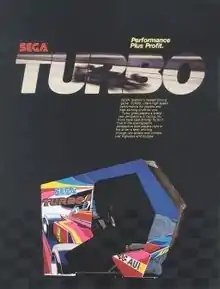Turbo (video game)
Turbo (ターボ Tābo) is a racing game released in 1981 by Sega.
| Turbo | |
|---|---|
 North American arcade flyer | |
| Developer(s) | Sega |
| Publisher(s) | Sega |
| Designer(s) | Steve Hanawa |
| Platform(s) | Arcade, ColecoVision, Intellivision |
| Release | Arcade October 1981[1] ColecoVision 1983[2] Intellivision 1983[3] |
| Genre(s) | Arcade-style racing |
| Mode(s) | Single-player |
| Arcade system | VCO Object |
The game was manufactured in three formats: standard upright, cabaret/mini, and a seated environmental/cockpit. All three versions feature a steering wheel, a gearshift for low and high gears, and an accelerator pedal. The screen is a vertically oriented 20-inch raster display. In addition to the on-screen display, Turbo features an LED panel to the left of the screen that displays the current player's score and the high score table. Turbo also features lighted oil and temperature gauges on either side of the steering wheel.[4]
Turbo was ported to the Colecovision and Intellivision home consoles.
Gameplay
Turbo requires the player to navigate a road race through different urban and rural locations, through differing weather conditions, and during changing times of day. The cars in the game resemble Formula 1 race cars. In order to proceed, the player must pass and stay ahead of at least 30 competing cars before time expires. Some opponents drive predictably, while others swerve across the road suddenly.
In the first round, the player has unlimited lives; collisions with other vehicles will return the player's car to the bottom of the current screen. In subsequent rounds, the player is limited to two lives (one on the screen playing and the other in reserve) and awarded an additional life (up to a total of four in reserve) for each completed round. In addition to competing racers, an ambulance occasionally comes along from behind and overtakes the player - they must be avoided, as contact with them will cause the player to lose a life; the game will be over when all player lives are gone in addition to the time expired before reaching 30 passed cars.
Development
Turbo was designed and coded by Steve Hanawa. In an interview, Hanawa stated that despite its historical significance as a precedent-setting racing video game, he considers the process of creating it to have been his worst development experience at Sega. Development of Turbo required such a difficult and protracted schedule of coding and debugging that he was hospitalized for a month following its completion due to stress, exhaustion and a spontaneously collapsed lung.[5]
Reception
| Publication | Score |
|---|---|
| AllGame | Arcade: CV: INTV: |
| Arcade Express | CV: 10 / 10[7] |
| Tilt | CV: |
| Publication | Award |
|---|---|
| 4th Arcade Awards | Best Coin-Op Game Audio/Visual Effects |
In Japan, Game Machine listed Turbo on their June 1, 1983 issue as being the fifth most-successful upright arcade unit of the year.[9] The arcade version of Turbo was reviewed by Computer and Video Games magazine's July 1982 issue. They praised the "Realism", controls, "marvellous graphical capabilities" and the "variety of backgrounds and racing conditions on the screen."[10]
Turbo was reviewed by Video magazine in its "Arcade Alley" column where it was hailed as "the king of the video road". The ColecoVision version was praised for the effort that had gone into replicating the visuals of the original arcade version, with reviewers making special note of the varied, non-repetitive backgrounds that enticed players to play in order to see "never-before-seen play scenes". Reviewers also commented favorably on the realism-enhancing use of steering wheel, gas pedal, and gear shift peripherals.[11]:28
Arcade Express reviewed the ColecoVision version in January 1983 and scored it a perfect 10 out of 10, remarking that the "king of the coin-op driving games arrives in the home market". They stated that while it isn't "as graphically arresting as the" arcade version, it "comes reasonably close to matching the multi-scenario brilliance" and "the special control panel lifts this cartridge to greatness."[7]
Legacy
An Atari 2600 port by Coleco was in development and advertised by Coleco, but it was never completed, due in part to the lead programmer, Michael Green, having been struck and seriously injured by a drunk driver while riding a bicycle. The prototype, estimated to be about 80% complete, was found by another Coleco programmer, Anthony Henderson, in his attic in 2006.[12]
A Turbo board game was released by Milton Bradley in 1983.[13]
References
- "Turbo arcade video game by SEGA Enterprises (1981)". www.arcade-history.com.
- "Turbo - Review - allgame". 10 December 2014. Archived from the original on 2014-12-10.
- "Turbo - Overview - allgame". 10 December 2014. Archived from the original on 2014-12-10.
- http://www.arcade-museum.com - Turbo - video game by Sega
- http://www.smstributes.co.uk - Steve Hanawa's Tech Talk
- "Turbo - Review - allgame". 11 December 2014. Archived from the original on 2014-12-11.
- "Newsletter" (PDF). www.digitpress.com.
- Tilt, issue 7 (September/October 1983), page 46
- "Game Machine's Best Hit Games 25 - アップライト, コックピット型TVゲーム機 (Upright/Cockpit Videos)". Game Machine (in Japanese). No. 213. Amusement Press, Inc. 1 June 1983. p. 29.
- "CVG Magazine Issue 009". 1 July 1982 – via Internet Archive.
- Kunkel, Bill; Katz, Arnie (April 1983). "Arcade Alley: Zaxxon, Turbo, and Two for Apple II". Video. Reese Communications. 7 (1): 26, 28–29. ISSN 0147-8907.
- http://www.atariage.com - Turbo - AtariAge
- http://segaretro.org - Turbo - Sega Retro